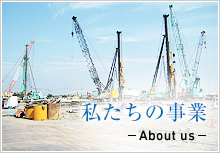2007.08.01
LARGE-SCALE CYCLIC SHEAR BIN TO EVALUATE METHODS FOR MITIGATING LIQUEFACTION HAZARD(S&F1986)
YOSHIAKI YOSHIMI・YOSHITAKA HOSOKAWA・FUMIO KUWABARA and KOHJI TOKIMATSU
■掲載誌:SOILS AND FOUNDATIONS,Vo.26,No.3, p137-142
■発行所:土質工学会
■発行:1986/9
A new test facility for inducing liquefaction in a large mass of saturated sand by cyclic shear is described. The sand specimen is 4 m wide, 6 m long, and about 5 m deep, and the cyclic shear stresses are applied by rotating a pair of walls hinged at the bottom, thereby = forcing the sand specimen to deform. Based on elastic stress analysis, the ratio between the cyclic shear stress and the vertical effective stress is nearly constant within the middle part of the specimen, simulating the probable condition in level ground during earthquakes. When liquefaction is induced, the behavior of the sand is similar to that which has been observed in the field during actual earthquakes, and the time histories of excess pore water pressure and shear deformation are also similar to those which have been observed in shaking table tests on saturated sand. Thus, the test facility can induce liquefaction in a large mass of sand at a fraction of the cost of shaking table tests. The large size and sturdy construction of the facility enables one to follow normal construction procedures in preparing realistic test specimens for evaluating the effectiveness of various methods to mitigate liquefaction hazard.
■発行所:土質工学会
■発行:1986/9
A new test facility for inducing liquefaction in a large mass of saturated sand by cyclic shear is described. The sand specimen is 4 m wide, 6 m long, and about 5 m deep, and the cyclic shear stresses are applied by rotating a pair of walls hinged at the bottom, thereby = forcing the sand specimen to deform. Based on elastic stress analysis, the ratio between the cyclic shear stress and the vertical effective stress is nearly constant within the middle part of the specimen, simulating the probable condition in level ground during earthquakes. When liquefaction is induced, the behavior of the sand is similar to that which has been observed in the field during actual earthquakes, and the time histories of excess pore water pressure and shear deformation are also similar to those which have been observed in shaking table tests on saturated sand. Thus, the test facility can induce liquefaction in a large mass of sand at a fraction of the cost of shaking table tests. The large size and sturdy construction of the facility enables one to follow normal construction procedures in preparing realistic test specimens for evaluating the effectiveness of various methods to mitigate liquefaction hazard.

